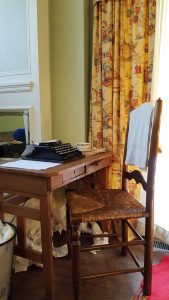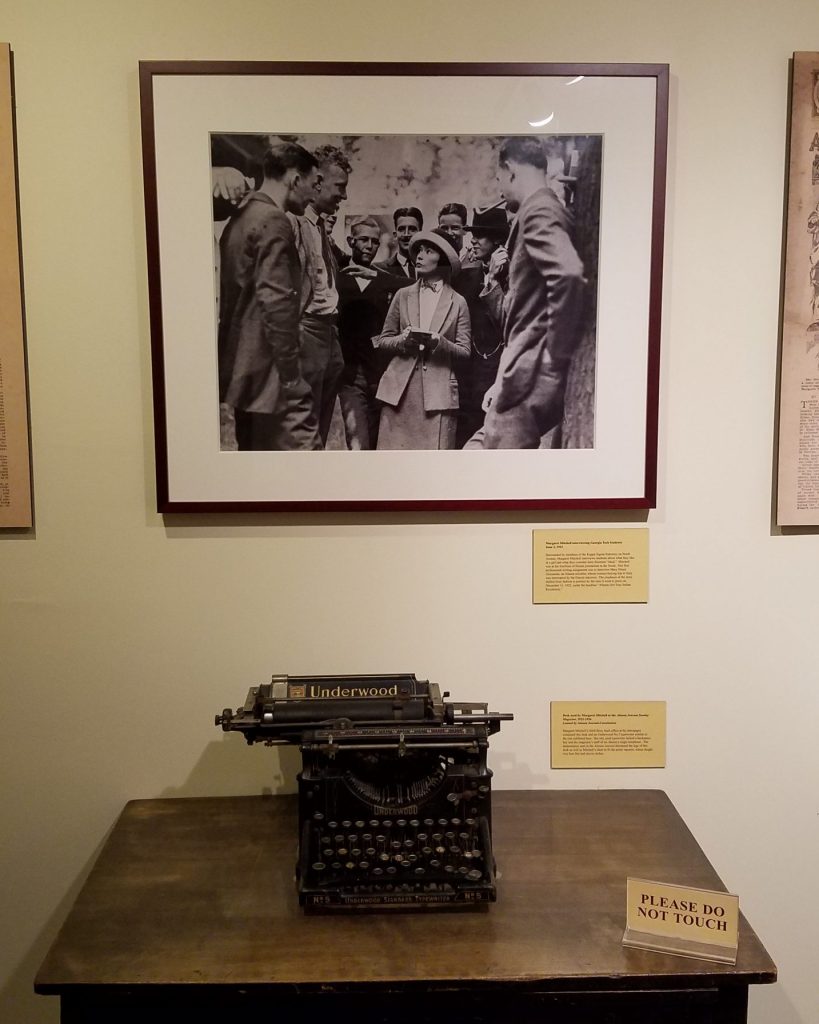ECW Weekender: The Margaret Mitchell House
I think there’s a kinship of writers and authors across the centuries. Everyone who has labored over a manuscript has gone through the same experience, though experienced the process in different ways. I have a fascination with the stories of how and where writers write. Jane Austen scribbled at a small table, sometimes tucking away her stories from prying eyes. Hemingway at his typewriter. The list goes on and on.
When I made a 24-hour trip to Atlanta, I knew I would spend time at a Civil War battlefield, but I also wanted to choose something in the city to see and tour. Margaret Mitchell’s home seemed like a perfect fit: author, history, and Civil War pop-culture all in one place. And, I was doubly-curious. I had spent about nine months reading her biographies, analysis of her writing and research, and, of course, her lengthy novel: Gone With The Wind. It seemed like a wonderful way to return to my GWTW project and revisit the topic I had explored for ECW’s new book!

It was a quiet week-day morning when I pulled into the small parking lot in front of the modest structure at 979 Crescent Ave NE in Atlanta, Georgia. Waiting for the museum to open, I thought about the novel and movie which had captured American (and International) imagination about the Civil War since the 1930’s. I thought about what I wanted to learn by visiting.
When the museum opened, I ventured inside and friendly staff and volunteers gave me a warm Southern welcome. While waiting for the tour to begin, I explored the galleries, taking in the information about Hollywood’s saga with Mitchell’s book and the movie’s premiere in Atlanta during December 1939.
An informative tour guide took me and a couple of other women through the galleries about Mitchell’s life, sharing the wonderful stories of the lady who challenged, overcame, and created. Margaret—called Peggy—by her family and friends grew up in a time of change and eventually forged her own way as a pioneer female journalist in traditional Atlanta. She survived family tragedy and an abusive marriage before settling into a kinder relationship and marriage with John Marsh, who encouraged her writing. Peggy and John lived in a first-floor apartment in the building now called “The Margaret Mitchell House.”

The apartment is part of the tour and includes refurnished rooms based on letter notes and hints on how the rooms looked when Margaret lived there. She called this apartment home “The Dump” but hosted plenty of friends into this small space. When an injury kept her housebound and she had read through most of the Atlanta library (thanks to her husband who toted home several volumes each day for her!), she took John’s advice and started to write her own book.
She kept her writing a secret, hiding manuscript pages in manila envelopes and stashing them under the couch, beneath cushions, and in a variety of other creative places to avoid questions from friends. Margaret wrote the last chapter of her novel first. The first chapter was the final addition and she struggled with how to start the story. She claimed she had only written for her own amusement and in later years would carefully adhere to her story that she was just “an Atlanta housewife” who had written a novel in her “spare time.”
But fame and fortune came. On a whim and in response to an acquaintance’s pointed criticism, Margaret dropped off her stack of envelopes to a literary agent. A contract from Macmillian followed and in 1936, Gone With The Wind, hit the shelves with one of the most successful marketing campaigns. The novel became an instant bestseller. Hollywood came next.
Margaret disliked the fame and the twisting of her story. But she was always publically gracious and made a point to answer all her fan mail—an extensive writing project! She used her earnings to support charitable efforts and also lent her name and pen to World War II morale and fundraising projects.
Wandering through the rooms where Peggy had read, dreamed a story, plotted a manuscript, and carefully stashed her secret project, I tried to set aside the novel’s influence on pop-culture perceptions of the Civil War and just appreciate the authoress. To separate Margaret from Scarlett. Admittedly, there are parts of Margaret Mitchell’s life that seem to clearly parallel some of the trials and triumphs for her fictional character. But with respect for an author’s word and the tale she told the press, I tried to believe that the famous novel was just a story, never based on real people. We all know that authors tend to “write what they know,” but if Margaret wanted to be remembered without being thrust into her own novel, I would try.

As I had the chance to see Margaret Mitchell’s life in the setting of her little apartment, I was reminded and inspired by her story. I spent some extra time looking at her original typewriter and thinking about the glass-ceilings that she shattered. Taking a job. Competing with men for journalism opportunities. Pushing the limits in Atlanta society in a variety of public and hidden ways. Taking the study of history seriously and trying to produce a story that reflected the family and local tales she knew and the culture she had always known. Did she do it perfectly? No, of course not. No one does. But she wrote a story that has lasted over eighty years with continued popularity.
And that was one of the lovely and inspiring takeaways for me. I was reminded of the breakthrough for women in journalism and novel-writing that Margaret Mitchell accomplished. Pop-culture interpretation and criticism of her book, Hollywood’s movie, and the effects abound, but that should not influence or limit our appreciation of this American author whose writing changed the way the Civil War has been viewed.
Margaret Mitchell House
Check their website for details on hours and admission tickets: https://www.atlantahistorycenter.com/explore/destinations/margaret-mitchell-house


One of my favorite authors and a wonderful inspiration. I look forward to visiting her home sometime this year.